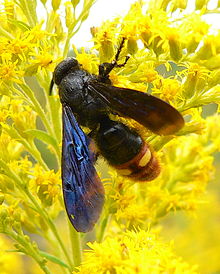| Revision as of 03:33, 17 August 2014 editOculi (talk | contribs)Extended confirmed users, Pending changes reviewers248,148 edits →References: clean up + insects cat using AWB← Previous edit | Revision as of 17:17, 1 October 2015 edit undoHorsePunchKid (talk | contribs)Extended confirmed users4,945 editsm Fixed access dateNext edit → | ||
| Line 13: | Line 13: | ||
| }} | }} | ||
| '''''Scolia dubia''''', also known as the '''blue-winged wasp''', is a {{convert|2.0|-|2.5|cm|1|adj=on|sp=us}} long wasp that ranges from ] to ] and west to the ] in North America.<ref name="bugguide">{{cite web|url=http://bugguide.net/node/view/431|title=Species ''Scolia dubia'' - Blue-winged Wasp |accessdate=October 8, 2011 |
'''''Scolia dubia''''', also known as the '''blue-winged wasp''', is a {{convert|2.0|-|2.5|cm|1|adj=on|sp=us}} long wasp that ranges from ] to ] and west to the ] in North America.<ref name="bugguide">{{cite web|url=http://bugguide.net/node/view/431|title=Species ''Scolia dubia'' - Blue-winged Wasp |accessdate=October 8, 2011|work=Bug Guide}}</ref> The head, thorax, and first two abdominal segments are black, while the remainder of the abdomen is red with two bright yellow spots on the third abdominal segment. The ] section of the blue-black wings has longitudinal wrinkles. These wasps nectar on flowers in late summer and early fall.<ref name=NatureSearch>{{cite web|url=http://www.fnanaturesearch.org/index.php?option=com_naturesearch&task=view&id=125&cid=132 |title=''Scolia dubia'' |accessdate=October 8, 2011 |work=Nature Search}}</ref> | ||
| Females burrow into ground in search of grubs, particularly those of the green June beetle, '']'', and the Japanese beetle, '']''. The wasp stings the grub and frequently burrows farther down to construct a cell and lay an egg on the host. The larva pupates and overwinters inside the body of the host.<ref name=bugguide/> The Blue-winged wasp preys on the Japanese beetle, both of which are native to Japan. | Females burrow into ground in search of grubs, particularly those of the green June beetle, '']'', and the Japanese beetle, '']''. The wasp stings the grub and frequently burrows farther down to construct a cell and lay an egg on the host. The larva pupates and overwinters inside the body of the host.<ref name=bugguide/> The Blue-winged wasp preys on the Japanese beetle, both of which are native to Japan. | ||
Revision as of 17:17, 1 October 2015
| Scolia dubia | |
|---|---|

| |
| Scientific classification | |
| Kingdom: | Animalia |
| Phylum: | Arthropoda |
| Class: | Insecta |
| Order: | Hymenoptera |
| Superfamily: | Vespoidea |
| Family: | Scoliidae |
| Genus: | Scolia |
| Species: | S. dubia |
| Binomial name | |
| Scolia dubia Say, 1837 | |
Scolia dubia, also known as the blue-winged wasp, is a 2.0–2.5-centimeter (0.8–1.0 in) long wasp that ranges from New England to Florida and west to the Rocky Mountains in North America. The head, thorax, and first two abdominal segments are black, while the remainder of the abdomen is red with two bright yellow spots on the third abdominal segment. The distal section of the blue-black wings has longitudinal wrinkles. These wasps nectar on flowers in late summer and early fall.
Females burrow into ground in search of grubs, particularly those of the green June beetle, Cotinis nitida, and the Japanese beetle, Popillia japonica. The wasp stings the grub and frequently burrows farther down to construct a cell and lay an egg on the host. The larva pupates and overwinters inside the body of the host. The Blue-winged wasp preys on the Japanese beetle, both of which are native to Japan.
References
- ^ "Species Scolia dubia - Blue-winged Wasp". Bug Guide. Retrieved October 8, 2011.
- "Scolia dubia". Nature Search. Retrieved October 8, 2011.
This Apocrita-related article is a stub. You can help Misplaced Pages by expanding it. |